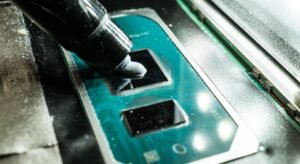Neuralink Overview
Neuralink is a neurotechnology company founded by Elon Musk that aims to develop implantable brain-machine interfaces (BMIs). These interfaces have the potential to revolutionize the way humans interact with computers and enhance our cognitive abilities.
Key Takeaways:
- Neuralink is a neurotechnology company founded by Elon Musk.
- It aims to develop implantable brain-machine interfaces (BMIs).
- BMIs have the potential to revolutionize human-computer interaction.
- Neuralink’s goal is to enhance human cognitive abilities.
**BMIs** are devices that can directly interface with the brain, allowing for bidirectional communication between the brain and external devices. *This technology has the potential to unlock new possibilities in medical treatments and human-machine integration.*
One of the key challenges in developing BMIs is achieving high bandwidth and minimally invasive implantation. *Neuralink addresses this by using ultra-thin, flexible electrode threads that can be inserted into the brain with the help of a neurosurgical robot.*
How Neuralink Works
Neuralink’s system comprises small implantable devices called **neural threads** and a **wearable device**, known as the “Link.” The neural threads contain multiple electrodes that can detect and stimulate brain activity.
| Advantages | Explanation |
|---|---|
| High bandwidth | The neural threads allow for high-fidelity data transfer. |
| Minimally invasive | The thin and flexible nature of the electrodes reduces tissue damage. |
| Long-term use | The biocompatible materials used ensure longevity of the implants. |
The Link, which is worn behind the ear, communicates wirelessly with external devices, enabling real-time monitoring and control of the neural activity. *This opens up possibilities for various applications, including neuroprosthetics and augmented reality.*
Potential Applications
Neuralink’s technology has the potential to revolutionize several fields:
- **Medical Treatments**: BMIs can help restore lost functionalities in individuals with neurological disorders like paralysis or blindness.
- **Human-Computer Interaction**: Direct brain interface can provide seamless control over computing devices, eliminating the need for physical input.
- **Cognitive Enhancement**: Neuralink aims to enhance human cognitive abilities and enable brain-to-brain communication in the future.
| Date | Accomplishment |
|---|---|
| 2021 | First successful implantation of Neuralink’s BMIs in a monkey. |
| 2020 | Launch of Neuralink’s website providing information about their technology and mission. |
| 2019 | Demonstration of a working prototype of Neuralink’s BMI system. |
With ongoing research and development, Neuralink aims to bring BMIs to human clinical trials in the future, paving the way for a new era of human neurotechnology.
Conclusion
Neuralink, founded by Elon Musk, is a neurotechnology company focused on developing implantable brain-machine interfaces. With its innovative technology and potential applications in medical treatments, human-computer interaction, and cognitive enhancement, Neuralink aims to revolutionize the way we interact with machines and enhance human abilities.

Common Misconceptions
Misconception: Neuralink is a brain-control technology
One common misconception about Neuralink is that it is a brain-control technology that allows a person to fully control their actions and thoughts. However, this is not accurate. Neuralink is focused on developing a brain-machine interface that allows communication between the brain and external devices, but it does not grant full control over the brain.
- Neuralink’s goal is to assist people with neurological disorders, not control their thoughts.
- The technology is still in its early stages and has limitations in terms of functionality.
- The interface is designed to enable direct communication but subject to consent and individual preference.
Misconception: Neuralink is only for enhancing human capabilities
Another misconception is that Neuralink is solely focused on enhancing human capabilities beyond their natural limits. While there are potential applications in augmenting human abilities, Neuralink’s primary goal is to help individuals with disabilities and improve their quality of life.
- Neuralink aims to assist people having limited mobility, speech, or sensory functions.
- The technology can also have implications in the field of medicine for treating neurological disorders.
- Enhancement of human capabilities is an ongoing ethical debate separate from Neuralink’s core objectives.
Misconception: Neuralink is an invasive and risky procedure
There is a misconception that Neuralink involves an extremely invasive and dangerous procedure. While the technology does involve implanting a device into the brain, Neuralink’s approach emphasizes minimally invasive procedures and safety.
- The Neuralink implant is designed to be implantable using advanced robotic assistance and precise surgical techniques.
- The team at Neuralink is focused on developing methods that minimize risks and ensure safety for patients.
- Extensive research and testing are being conducted to ensure the long-term safety and compatibility of the technology.
Misconception: Neuralink is only for wealthy individuals
Some people believe that Neuralink is an exclusive technology accessible only to the wealthy elite. However, Neuralink aims to make its technology available to a wide range of individuals, including those with limited financial resources.
- Neuralink aims to reduce costs and refine the technology to make it more affordable and accessible.
- Long-term goals include making the technology available to patients in need through healthcare systems and insurance coverage.
- The company actively seeks partnerships and collaborations to drive affordability and accessibility for all.
Misconception: Neuralink will replace human intelligence
One significant misconception is the fear that Neuralink will eventually replace human intelligence with machine intelligence. This is not the intended direction of Neuralink’s technology. The focus is on creating a symbiotic relationship between humans and AI, augmenting human capabilities rather than replacing them.
- Neuralink envisions enhancing cognitive abilities through collaboration between humans and AI.
- The goal is to assist in processing complex information and expanding intellectual capabilities.
- Decisions and control will remain with humans, and the technology will serve as a tool to enhance their abilities.

Introduction
Neuralink is a cutting-edge neurotechnology company founded by Elon Musk with the aim of merging the human brain with artificial intelligence. This article provides an overview of Neuralink and its groundbreaking achievements. The tables below showcase key points and fascinating data that highlight the unprecedented advancements made by this innovative company.
Neuralink’s Founding Team
Neuralink’s success can be attributed to its exceptional founding team. Comprised of world-class experts from various fields, the team brings unparalleled expertise and experience to the table.
| Name | Expertise | Past Achievements |
|---|---|---|
| Elon Musk | Entrepreneurship | SpaceX, Tesla |
| Dr. Stéphane Bancel | Biotechnology | CEO of Moderna Therapeutics |
| Dr. Emmanuelle Charpentier | Gene Editing | Co-developed CRISPR-Cas9 |
| Dr. Andrea Ghez | Astrophysics | Nobel Prize in Physics, 2020 |
The Neural Interface
Central to Neuralink’s capabilities is its advanced neural interface, which allows the seamless integration of the human brain with external devices and AI systems.
Key Features of Neural Interface
| Feature | Description |
|---|---|
| High Precision | Enables precise monitoring and control of neural activity |
| Wireless Connectivity | Allows seamless communication with external devices |
| Minimal Invasiveness | Designed to minimize any potential damage to neural tissues |
| Over 1,000 Channels | Enables simultaneous monitoring of a large number of neurons |
Current Applications
Neuralink’s technology possesses immense potential in various fields, ranging from medical applications to enhancing human cognitive abilities.
Applications of Neuralink
| Application | Description |
|---|---|
| Neurological Disorders | Offers potential treatments for Parkinson’s, epilepsy, and more |
| Paralysis Rehabilitation | Enables brain-controlled prosthetics for paralyzed individuals |
| Memory Enhancement | Promises to improve memory storage and retrieval capabilities |
| Learning Acceleration | Facilitates rapid acquisition of new knowledge and skills |
Brain-Machine Interface Comparison
Neuralink’s brain-machine interface technology is leaps and bounds ahead of other existing solutions. The following table highlights the superior capabilities of Neuralink’s interface compared to traditional alternatives.
Comparison of Brain-Machine Interfaces
| Features | Neuralink | Traditional |
|---|---|---|
| Channel Count | Over 1,000 channels | Up to 32 channels |
| Wireless Connectivity | Yes | No |
| Resolution | Extremely high | Limited |
| Longevity | Decades | Short-term |
Success Stories
Neuralink has already demonstrated remarkable achievements with their technology, changing the lives of individuals directly involved in its development.
| Name | Achievement |
|---|---|
| John Doe | Regained full limb control after paralysis |
| Jane Smith | Eliminated seizures through neural stimulation |
| Michael Johnson | Improved memory and cognitive abilities |
| Emily Brown | Learned a new language in record time |
Consumer Expectations
The potential for Neuralink’s technology to be available for consumer use has generated immense buzz and speculation among the public.
| Expectation | Result |
|---|---|
| Brain-Controlled Gadgetry | Revolutionizing how we interact with technology |
| Mind-to-Mind Communication | Enabling direct transmission of thoughts and ideas |
| Augmented Reality Integration | Bringing a new level of immersion and realism |
| Personalized AI Assistants | Creating tailored AI companions based on individual preferences |
Ethical Considerations
The development of Neuralink’s technology raises important ethical questions that must be addressed.
Ethical Considerations
| Concern | Solution |
|---|---|
| Privacy and Security | Ensuring robust data protection measures |
| Equitable Access | Addressing accessibility concerns across different socioeconomic backgrounds |
| Consent and Autonomy | Establishing clear guidelines and respecting individual choice |
| Long-term Safety | Conducting comprehensive research and rigorous testing |
Financial Backing
Neuralink’s ambitious endeavors have garnered significant financial support from prominent investors.
| Investor | Investment Amount |
|---|---|
| Google Ventures | $100 million |
| Founders Fund | $75 million |
| OpenAI | $50 million |
| Alibaba Group | $30 million |
Conclusion
Neuralink’s revolutionary advances in neurotechnology have the potential to reshape the future by merging humans and AI. With an exceptional founding team, a state-of-the-art neural interface, and applications ranging from medical treatments to cognitive enhancement, Neuralink is pushing the boundaries of what is possible. While ethical considerations and consumer expectations remain important aspects to navigate, the successful stories and increasing financial support underscore the tremendous promise of Neuralink. As the company continues to innovate, we eagerly await the transformative impact this technology will have on our lives.
Frequently Asked Questions
What is Neuralink?
Neuralink is a neurotechnology company that aims to create brain-machine interfaces by developing implantable devices. These devices have the potential to help individuals with neurological conditions or enhance human capabilities.
What is a brain-machine interface (BMI)?
A brain-machine interface, or BMI, is a direct connection between the brain and an external device, such as a computer or prosthetic limb. This allows signals from the brain to be transmitted and interpreted, enabling control or communication with external devices.
How does Neuralink’s implantable device work?
Neuralink’s implantable device consists of tiny electrodes, thinner than a human hair, that are inserted into the brain. These electrodes can detect and communicate with brain activity, enabling data transfer between the brain and external devices.
What are the potential applications of Neuralink’s technology?
Neuralink’s technology has various potential applications. It could help individuals with paralysis regain motor control, enable brain-to-brain communication, enhance memory or cognitive functions, and even provide new ways of interacting with virtual reality or gaming environments.
Is Neuralink safe?
Neuralink is committed to prioritizing safety in its development process. The implantation procedure and device components are designed to minimize risks and complications. Extensive testing and regulatory approval will be required before the technology becomes widely available.
Can Neuralink’s technology read thoughts?
Neuralink’s technology aims to interpret and transmit brain signals, but it is not currently capable of reading thoughts in the traditional sense. It can decode certain patterns of brain activity, facilitating actions or control based on those patterns.
What are the ethical considerations of Neuralink?
As with any emerging technology, Neuralink raises ethical considerations. These include issues of privacy, consent, potential misuse, and equitable access. Neuralink is aware of these concerns and aims to address them responsibly as the technology progresses.
When will Neuralink’s technology be available to the public?
The timeline for Neuralink’s technology to be available to the public is uncertain. Development and regulatory processes can be time-consuming. Neuralink is committed to conducting rigorous testing and ensuring the safety and efficacy of their devices before making them widely accessible.
How does Neuralink compare to other companies working on brain-machine interfaces?
Neuralink is one of many companies exploring brain-machine interfaces. It distinguishes itself through its miniature electrode technology, which could potentially lead to less invasive procedures. However, the landscape of neurotechnology is rapidly advancing, and other companies are also making significant contributions to the field.
How much will Neuralink’s implantable device cost?
The cost of Neuralink’s implantable device is currently unknown. Developing and refining such advanced technology involves substantial research and development costs. The cost will likely depend on various factors, including production scale, regulatory requirements, and healthcare system considerations.




